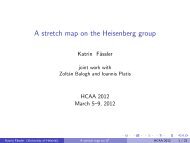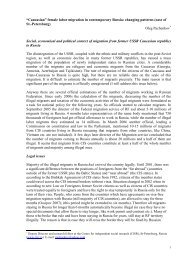THORIUM AS AN ENERGY SOURCE - Opportunities for Norway ...
THORIUM AS AN ENERGY SOURCE - Opportunities for Norway ...
THORIUM AS AN ENERGY SOURCE - Opportunities for Norway ...
Create successful ePaper yourself
Turn your PDF publications into a flip-book with our unique Google optimized e-Paper software.
Thorium as an Energy Source - <strong>Opportunities</strong> <strong>for</strong> <strong>Norway</strong><br />
15. APPENDIX C: EDUCATION <strong>AN</strong>D TRAINING<br />
Finland:<br />
The following courses are initiated or will be started at Åbo Akademi:<br />
• Fall 2006 Nuclear Structure<br />
• Spring 2007 Emerging Nuclear Energy Systems I (ENES-I)<br />
• Spring 2007 Radiation Safety<br />
• Fall 2007 Radiation Safety Laboratory<br />
• Fall 2007 Nuclear Physics<br />
• Spring 2008 Radiation Safety (+ Laboratory if needed)<br />
• Spring 2008 Not yet decided, may be ENES-I/II or Reactor Physics<br />
The program has been discussed with the following parties and has received very positive<br />
response from the following institutions:<br />
Olkiluoto Reactor Plant, Helsinki University of Technology, Advanced Energy Systems, Fortum<br />
Nuclear Services, STUK, the Finnish Radiation and Nuclear Safety Authority, Technical Faculty<br />
of Åbo Akademi, Neutron Physics, the Royal Institute of Technology (KTH), Stockholm.<br />
Sweden:<br />
Göteborg, Chalmers University of Technology:<br />
Undergraduate courses in nuclear engineering are collected as a special “line” (inriktning in<br />
Swedish) in the master program in “Applied Physics”. A volume of 30 ECTS in nuclear<br />
engineering courses, divided to 4 courses, each consisting of 7.5 ECTS. The courses are given<br />
jointly by the groups (<strong>for</strong>merly departments) of Nuclear Engineering and Nuclear Chemistry,<br />
Chalmers. All courses are given during the fall semester, whereas the spring is designated <strong>for</strong> the<br />
master thesis (diploma) work.<br />
The courses contain about 2 laboratory exercises per package, with written reports. In the spring<br />
term, or incidentally in the summer, the students per<strong>for</strong>m a one-week long laboratory course at<br />
reactors at a research institute. During a very long period, these were made in Studsvik. Since<br />
the closing of the R2 and R2-0 reactors in Studsvik, the laboratory exercises were per<strong>for</strong>med at<br />
the Kyoto University Research Reactor Institute. The current course package is meant to<br />
represent a broad basis in nuclear engineering, and has, in an overview, the following content<br />
shown in the Table 15.1 below.<br />
116

















